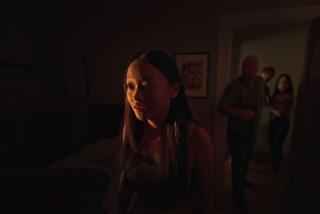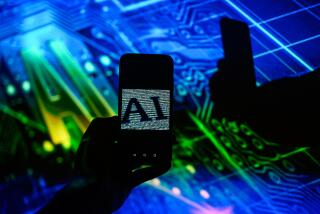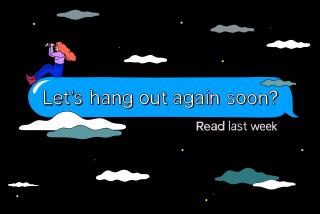Mind-blowing robot conjures ghosts in the lab
- Share via
It’s never too late for a little Halloween creepiness. At least not for a group of Swiss researchers who managed to make unwary subjects feel as if they had been tapped by a ghost.
A couple of the bindfolded volunteers thought the experience was so creepy they almost quit, according to neuroscientist Giulio Rognini of the Federal Polytechnic School in Lausanne, Switzerland, who is lead investigator of a study published online Thursday in the journal Current Biology.
The experiment is akin to an old magic trick: the rubber hand illusion. By stroking someone’s hand placed on one side of a partition while that person views a fake one being stroked on the other side, the brain can be duped into “adopting” the fake hand. And people’s perception of where their hand is located “drifts” toward the position of the fake one.
Researchers have modernized the trick using video cameras to make people seem as if they’re viewing their own backs, for instance. Their studies help explain not just how we orient ourselves in space but how we distinguish our physical selves from everything else, a distinction that lies at the heart of psychiatric disorders such as schizophrenia.
Finding a potential biological root for the creation of hallucinations could offer pathways to a treatment. It also may offer clues to the ubiquity of accounts of a “presence” – sinister or beneficent - in folklore, religion and literature.
Rognini, who also holds a degree in robotics, designed a mechanical device that would poke volunteers on their backs when they moved a joystick in front of them. That gave the brain a bit of a conflict to resolve. While it was clear from arm movement feedback that the joystick was in front, the poke sensation was on the back.
If the back-poke sensation was roughly simultaneous with the joystick’s forward motion, volunteers reported the odd perception that they were touching their own back. The brain “resolved” the spatial conflict in a similar manner to the rubber hand illusion. Most people found the physical absurdity amusing.
But when researchers introduced a delay, things got sinister. Volunteers became convinced that someone else had poked them, and when quizzed about how many people were in the room, they consistently added as many as four bodies to their local census, according to the study. Their perceptions of where their own bodies were located in the room also “drifted” toward the robotic poker.
“It’s important to emphasize that it’s a feeling,” Rognini said. “It’s not a rational account for this.”
The rational accounts for the perceptions come later, and often.
“These experiences are massively influenced by culture” Rognini said. “Of course, we cannot say that all the feelings of a presence can be explained by our model.”
Several such narratives inspired the Swiss researchers – mountaineers in low-oxygen and high stress expeditions have reported a strong sensation that someone was shadowing them, the authors noted.
In fact, that’s generally where most people report the presence – behind their backs, and in the same posture. “It’s like the body of the presence is mimicking the posture and movement of the patient,” Rognini said.
Patients with brain lesions in an area roughly above and behind the ear often suffer from such hallucinations, and they report the “presence” behind their backs as well.
Because that area of the brain, called the temporoparietal cortex, is crucial to our sense of self-awareness, movement and orientation, researchers hypothesized that conflicts arising in sensorimotor signaling might be at the heart of hallucinations. Confronted with stimuli that are disjointed, the brain makes a critical perceptual “mistake” – it shifts the line between self and other.
Prediction factors into the perceptual error, the researchers hypothesize. Through experience, the brain associates motor commands with consequences. When the prediction matches the sensory feedback – reaching becomes touching, for instance – the mind interprets the phenomenon as self-generated. When the prediction and outcome don’t align, however, the mind can attribute the sensation to an outside agent.
Finding a biological root to how we attribute agency and draw the line between self and other could have profound implications beyond folklore or abnormal psychology, said Rognini.
“A big part of understanding consciousness is to understand body self-consciousness.”
The study demonstrates “remarkable levels of malleability of our representations of our body,” said Matthew Longo, a cognitive neuroscientist at Birkbeck University of London who has conducted similar research. He was not involved in the study.
By relegating such experiences to the supernatural, science may be missing an opportunity to gain insight into a fundamental brain function, Longo noted. “This line of research has the potential to ‘naturalize’ the feeling of presence, making it a tractable and legitimate object of scientific study.”
Creeped out by science? Follow me on Twitter: @LATsciguy







